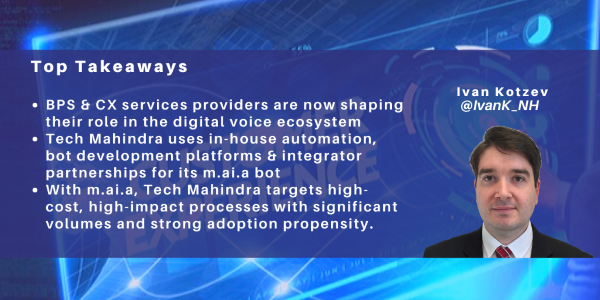posted on Nov 01, 2019 by Ivan Kotzev

Voice bots are a tiny part of the customer service and outsourced CX services market today. However, they are significant both in terms of investment and the attention they are receiving from organizations. In both smart home devices (voice assistants) and traditional telephony, voice bots are growing (*see a sample of news items from October 2019 at the end of the text).
With diverse markets, from automotive to healthcare, with multiplying uses cases from food ordering to job applications, growing adoption in the U.S. and U.K., the addition of new markets (e.g. Ireland) and higher frequency of use, the question for BPS and CX services providers is not when but how to get involved in the digital voice ecosystem. Here I look at how Tech Mahindra has entered the field.
Converting from human-human to human-bot interaction
Tech Mahindra BPS began developing its voice bot m.ai.a in early 2019, utilizing in-house ML and AI capabilities. It started with a simple Q&A bot able to support FAQ type queries. In the second phase, they introduced NLP and NLU into the bot to allow users to paraphrase their questions and receive responses. In the third phase, Tech Mahindra BPS introduced conversational features for the bot to respond to unstructured dialogue outside the Q&A format. Here the conversation can be multi-dimensional, and the bot will comprehend it.
The voice assistant processes data in real-time from systems such as CRM, ERP, billing, and knowledge management, and the algorithm builds a voice response back to the customer. For example, in a current pilot for a telecom client, the bot handles the first steps of a sales interaction and automatically schedules an outbound sales call in the dialer for a human agent to complete the sale. Tech Mahindra achieves this access through an API where available, and in the case of legacy applications it employs its own RPA script in the background to read/write the information.
Partnering in a complex ecosystem
There are different ways to build a bot solution currently: build a bot engine from scratch on Python or another language, customize one of the existing platforms, or create your own bot on existing frameworks from Google, IBM, Amazon, or Microsoft. The last option involves using a ready tool such as Avaamo, Conversocial, or one of many others.
Tech Mahindra combines several approaches. It uses Google Cloud Platform to create chat and voice bots, works with Amazon Lex and Amazon Lambda gateway API to integrate with back-end systems, and Amazon Connect for telephony integration. It also partners with Avaamo for the bot building.
Amazon in particular has an advantage, as it offers both the platform and connectivity and is able to effectively manage the integration of voice bots on a telephony platform. Tech Mahindra is working to deploy the bot over IVR and route it to a live agent if the bot does not understand or cannot respond to the query (a feature not available for smart speakers for now).
Uses cases in telecom
The initial POCs for m.ai.a are with telecom use cases such as price check or billing status update, activating roaming or bolt-on, and in service desk password resets. These processes have high enough volumes and sufficiently straightforward customer journeys to deploy the voice bot. Beyond these first target processes, Tech Mahindra is now looking (with telecom clients) to reduce truck rolls and engineer visits, with the bot guiding the user through technical support queries in scenarios related to faults with fixed line or broadband. The company is also working on similar use cases in the high-tech sector; for example, to help a home appliances manufacturer to schedule appointments and request replacement parts.
These processes are particularly malleable to voice automation as they deliver sizable cost savings with limited opportunities for self-service, especially when the user has no access to the internet. The bot also helps with addressing spikes in support calls during outages and disruptions.
Another key factor is customer propensity for adoption. Unlike a back-office RPA deployment with linear calculations, Tech Mahindra evaluates the ROI by demographic group, geography, and use case; for example, targeting 35-40% deflection in the U.S. in an active age group for technical support interactions.
From POCs to implementations of voice bots leveraging intelligent automation
To address the market potential and demand for CX automation, Tech Mahindra plans to grow its voice bot development team in the next few months. Part of these resources are curators and conversationalists with a degree in linguistics and communications who can develop an effective and natural dialogue. The curators also localize and culturally align the taxonomy and conversation style.
Tech Mahindra will continue to target the communications and high-tech sectors, the enterprise segment, and service desk functions. From a broader perspective, its objective is to implement voice bots in a broader offering, leveraging process orchestration and intelligent automation across the CX journey.
NelsonHall is currently developing a Cognitive Customer Experience market analysis report, analyzing the use of cognitive models and technology in customer experience by Fortune 2000 organizations.
* Related articles:
Reliance Jio launched video and voice call assistant for business clients
BBC adds interactive news on Alexa

